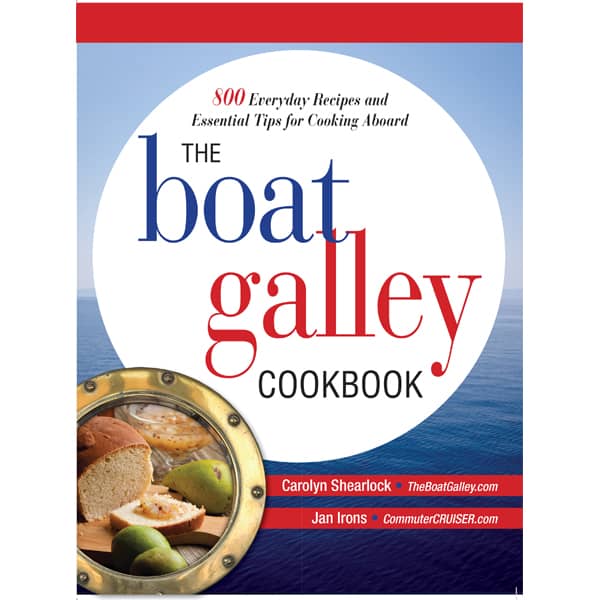Let’s talk a bit about eating when on passage and preparing meals for a passage. Some of the same principles apply whether it’s an all-day jump or a Pacific crossing!
Passage Meals Tip #1: Finger Foods
First off, we tend to “graze” more than eat sit-down meals, and almost everyone else I’ve talked to says the same thing. I learned this on our first overnight passage! You won’t find it practical to sit down to eat if the sea-state is choppy. Or if the boat is heeled over. And even if the off-watch crew is sleeping.
So, don’t plan on too many “real meals”. Keep your focus on healthy convenience foods.
We eat a lot of grab-and-eat snacks, but not junk food. Trail mix, yogurt, applesauce, raisins, boiled eggs, nuts, apples, oranges, cheese, pre-cooked chicken breast tenders, and sausage slices are all good. People are likely to eat more than they do normally unless conditions are very calm. Set up your passage meals like you are feeding an army of teenagers. Have plenty of high protein and carbs. Ideally items you can eat with one hand.
Passage Meals Tip #2: Pre-Packaged Foods
Another way to increase convenience is to purchase items in single-serving containers and/or package into single servings ahead of time so that it’s very easy to just grab something underway.
A favorite example is to pre-make sandwiches and have them bagged up and ready to grab out of the fridge. Having a stack of ready-made sandwiches is a big help when you’re hungry and need a relatively large meal. We use a slice of cheese between the bread and tomato to keep the juice from making the bread soggy but still get a nice, market-style sandwich with plenty of turkey meat. You can also make a batch of tuna or chicken salad that can easily be eaten with crackers and a piece of fruit.
Even though lots of snack foods come in single-serve containers, you can cut down on single-use plastic. Just make your own snack mixes and store them with a serving scoop inside the container.
Passage Meals Tip #3: Batch Cook Casseroles
Yep, that old standby, the casserole. Before you head offshore, it’s smart to make a few dinners in advance. This is for two reasons: (1) if someone has a tendency towards seasickness, the less time spent inside the boat, the better, and (2) if someone is on watch, they need to be on deck and not down fixing their snack.
If you know you’ll have a few days of queasy stomachs to start off with, make a batch of something nice and bland, like chicken and rice. Keeping bellies full of something starchy can help ease the symptoms of nausea. Pop in a couple of cups of broccoli or peas and carrots, and you’ll be set with a relatively nutritious meal that is easy on the tummy.
Other options include baked ziti, shepherd’s pie, enchiladas, chicken alfredo bake, and of course, the breakfast casserole. All these options can be easily reheated from frozen and eaten in a bowl with a spoon or fork. No knife required! Check out all our boat friendly recipes for options you’ll enjoy.
Remember that if you’re on a multi-day passage, time of day tends not to matter with what you eat since you’ll be sleeping at odd hours. Don’t think of things in terms of breakfast, lunch, and dinner. You very well might be eating your first meal of the day at noon!
Passage Meals Tip #4: Cooking Underway
Cooking underway takes some practice. But there are a few techniques (cooking and boat handling) that will make it a bit easier.
One-Skillet Recipes
Let’s say you’re on a multi-week passage and will run out of your pre-made meals – even the casseroles! Now’s the time to lean into those one-skillet recipes. You may be forced to get out ingredients and a pan but trying to cook underway should be made as simple and safe as possible.
Mise en Place
You can give yourself a head start on those one-skillet meals by handling your mise en place in advance – including pre-measuring the spices the recipe calls for. Think of it as preparing a meal kit so all you have to do is grab the containers and dump the ingredients in the pan. Remember to include something to thicken sauces, like a sprinkling of corn starch or flour so they don’t slosh.
Heave To
A word about using the stove and oven underway: If the sea state is making cooking underway too uncomfortable, heave-to for a half an hour and get your meal made. There is no reason to risk spilling a hot skillet all over the galley (and yourself!) to try and make some arbitrary deadline. Wind dies, squalls happen, sheets wrap on cleats, furlers bind, and meals must be made. Sometimes you just slow down and get the job done.
A final word about longer passages. Even without weather or mechanical challenges, passages are tough on your body, with heat or cold and watch standing. Avoid sugar crashes and sleepiness by limiting junk food and high carb treats. Use caffeine sparingly, since when you are off watch, you want to be able to sleep!
Passage Meals Tip #5: Keep the Weather in Mind
Hot or cold meals? It depends on the weather. If you’re hot, a cold meal is generally welcome, and hot food is a great comfort if it’s cold. Either way, try to prepare things ahead of time: a big bowl of pasta salad (with meat or cheese to make it hearty) or soup that can just be re-heated.
Cold, fresh fruit, especially juicy things like watermelon, really hits the spot on a hot day. And no one can resist a mug of hot cocoa on a cold, wet night! Never underestimate the joy a well-timed and thoughtful snack can bring to an exhausted crew member. These small joys can lift the morale of everyone and make happy memories of long passages.
Passage Meals Tip #6: Use Your Freezer
For a longer trip, mix up your pre-made meals as you pack them into the freezer, so that you can pull things out from the top without getting chili three days in a row. If you have to unpack the freezer to get to things in the bottom, you will never get things packed back in the same way!
You probably don’t have enough freezer space to pre-make enough meals for the whole trip, so if you are enjoying a relatively calm day, use that time to restock the freezer.
Above all, plan foods and meals that everyone aboard enjoys. A passage is not the time to try new recipes or figure that you can “stand to” eat something just for a few days. Tried and true favorites are best.
Passage Meals Tip #7: Have a Meal Together
I recommend that you plan to have one meal together each day. Otherwise, you really don’t get to spend much time with each other on passage – one of you will be on watch and the other, trying to get some sleep. And for that meal, I do try to have more of a meal, but still foods that are easy to eat if conditions are at all sporty.
Being able to change watch at sunset or sunrise and enjoy dinner or breakfast is a wonderful way to enjoy being on passage together.
Passage Meals Tip #8: Make Up Food-Related Rituals
In addition to toasting your first crossing of the Equator and pouring a shot for Neptune, make up your own rituals around food to create memories and mark the passage of miles under the keel. Some ideas include:
- Toast the sunrise with your morning coffee and express gratitude for safely making it through the night.
- With your evening meal or sundowner with the whole crew, do a round of Best, Worst, Surprise. (Take turns telling everyone the best, worst, and most unexpected thing that happened that day.)
- Pack a few Latitude Snacks (or Longitude Snacks) when you cross the next 5- or 10-degree line of latitude (or longitude). Bring something special from home, bake a treat, or make a special meal to mark those milestones and break up the passage.
- Make a point of having a “halfway cake” to celebrate the mid-point of long passages. (Hat tip to Sailing Totem for this one.)
- Enjoy a celebratory arrival beverage after pulling into port or greeting new crew members’ arrival. Break out the bubbly, cider, or a favorite rum and toast to your successful voyage!
Finally, enjoy the trip!

Carolyn Shearlock has lived aboard full-time for 17 years, splitting her time between a Tayana 37 monohull and a Gemini 105 catamaran. She’s cruised over 14,000 miles, from Pacific Mexico and Central America to Florida and the Bahamas, gaining firsthand experience with the joys and challenges of life on the water.
Through The Boat Galley, Carolyn has helped thousands of people explore, prepare for, and enjoy life afloat. She shares her expertise as an instructor at Cruisers University, in leading boating publications, and through her bestselling book, The Boat Galley Cookbook. She is passionate about helping others embark on their liveaboard journey—making life on the water simpler, safer, and more enjoyable.
Simplify meal prep on board with proven strategies for provisioning, maximizing fridge space, and cooking delicious meals aboard your boat.










Paul Harmina says
Very good information, especially concerning cooking under way. My favorite cookbook is “the One Pan Galley Gourmet”. I like only having one pot or pan to clean as well. As a delivery captain i like to make things as simple as possible
Stan says
Great Ideas.
We use our vacuum bagger a lot for trips. Pre measure rice, pasta, grits etc with the time to cook and amount of water for rice or grits. Just cut open the bag, dump in the boiling water, and time. Keeps for ever, no bugs or boxes. Also bag cooked manicotti, stuffed shells, crepe filling, soups that are kept frozen. pork chops, chicken, steak. All in serving size for the two of us (or if more people larger to suit). In vacuum bags the stuff keeps for 4 times longer than in zip lock bags.
Also vacuum daily servings of vitamins, Citrical, powdered drinks. Use 12 inch bags cut into 4 inch strips, seal between 6 segments. Keeps forever.
We have 3 boxes for the top loading freezer, bottom for last week, next for two weeks out etc.